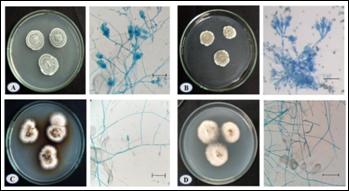Plant-Microbe Interaction studies in Himalayan Birch: A Threatened Timber Line Species
Betula utilis represents unique association of plants and microbes. However, due to over exploitation, natural calamities and changing environmental conditions, this ecologically and economically important species has become vulnerable and habitat alterations have started taking place. Microbial associations will also change with habitat alterations and climate change. Such changes may affect the mutual benefits of these species. The review of literature revealed that most studies have been carried out in isolation and studies integrating different component of B. utilis forests have not been carried out so far. In the present study population assessment of B. utilis was conducted in two districts of Himachal Pradesh i.e., Kullu and Kinnaur. Total 34 sites were assessed in Kullu district with altitude ranging between 2850 – 3760 m, amsl. While total 22 sites were surveyed in Sangla valley of Kinnaur district. Maximum sites were represented by Bouldary, followed by Shady moist, Riverine, and Dry habitat. The physico-chemical properties (pH, moisture content, percent organic carbon, available nitrogen, phosphorous and potassium) of soil was also assessed from each population sites of B. utilis. The soil enzymes activities, physico-chemical properties and root microbial colonization with reference to B. utilis rhizosphere region were done in different season and altitudinal gradients. The correlation analysis indicated that soil pH is negatively correlated with the altitude whereas Moisture content (%), Potassium (kg/ha), Phosphorus (mg/kg) and Nitrogen (kg/ha) were positively correlated with the altitude.
. Similarly, season and altitude affect the rhizosphere microbial activity and root colonization pattern which indicate that climate change may affect the plant-microbe interaction in birch species in near future. Total 10 culturable microbial diversity including 6 bacterial 4 fungal endophytes were associated with B. utilis roots. These endophytes harbor potential biotechnological application in particular reference to plant growth promoting activities at vast temperatures ranges (15-35ºC) and secondary metabolites production. The plant growth promoting activities of microbial endophytes associated with Himalayan silver birch species contributes for its growth and development in extreme Himalayan conditions. These microbe may contribute in B. utilis adaptation in future climatic conditions as the endophytic species have potential to tolerate vast temperatures ranges in in vitro conditions. The isolated endophytes having plant growth promoting properties may be used as microbial inoculant/biofertilizer for improving growth and production of high-altitude crops, and ecologically and economically important plants of Himalayan, and the fungal endophytes possess various pharmacological bioactive compounds which production can be scale up to meet commercial demand.


